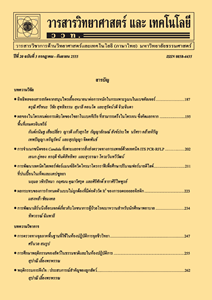ชนิดและสัดส่วนตัวประสานต่อคุณภาพถ่านกะลาตาลโตนดอัดแท่งโดยใช้ระบบอบแห้งพลังงานแสงอาทิตย์แบบเรือนกระจก
Main Article Content
Abstract
The palmyra palm shell is one of local biomass in Songkhla Province. This biomass is the residue from processing of ripe palmyra palm fruit. The production of palmyra palm shell charcoal briquettes (PSCBs) for using as biofuel in household and grinder restaurant is an interesting way. The objectives of this study were therefore to study the effects of binder types and ratios on the quality of PSCBs by using solar greenhouse drying (SGD) system. The quality of PSCBs was considered in terms of proximate analysis, ultimate analysis, heating value, compressive strength, density and crumbling. The drying kinetics, production cost and payback period of PSCBs were also studied. The binders that used in this study included tapioca flour, tapioca residue and native tapioca starch. The proportions of binders were 4, 7 and 10 % (wt), respectively. The spiral compression machine was used as charcoal briquettes making machine. The obtained PSCBs had hexagonal prism geometry with diameter of 5 cm, length of 10 cm and at the center of PSCBs has a hole with diameter of 1.5 cm. The moistened PSCBs were dried by SGD system until their final moisture content were lower than 8 % (wet basis). The results showed that drying of PSCBs with SGD system to the desired final moisture content can be done within 2 days. Type and ratio of binders had small effects on the quality of PSCBs, considering from the results of proximate analysis, ultimate analysis and heating value. The lower heating values (LHV) of PSCBs were in the range of 25.48-27.43 MJ/kg. Type and ratio of binders had effects on compressive strength, density and crumbling of PSCBs. Mixing of binders with the ratio of 4 % (wt) was not appropriate to produce the PSCBs due to they were highly crumbling. Production of PSCBs by adding the proposed binders with the ratios of 7 and 10 % (wt) obtained the PSCBs which pass the charcoal briquettes standard. However, adding more ratio of each binder into charcoal mixture led to higher smoke during burning of PSCBs. Production of PSCBs with 7 % (wt) of tapioca residue provided the lowest production cost and payback period.
Article Details
References
[2] Department of Alternative Energy Development and Efficiency, Ministry of Energy, 2018, Potential of Biomass in Thailand, Available Source: http://www.http://biomass.dede.go.th/biomass_web/index.html, 9 August 2018. (in Thai)
[3] Department of Agriculture Extension, Ministry of Agriculture and Cooperatives, Situation of palmyra palm plantation of Thailand in 2016, Available Source: http://www.agriinfo.doae.go.th/year60/plant/rortor/perennial/tantanode.pdf, 9 January 2019. (in Thai)
[4] Chumsang, C. and Upan, P., 2013, Value-added of Wastes from Palmyra Palm, Training Report: Technology Transfer for Value-added of Wastes from Palmyra Palm by Participation of the Community, Practical Knowledge Management to Community under the Project of Knowledge Management and Technology Transfer from Research and Innovation, National Research Council of Thailand, Bangkok, 44 p. (in Thai)
[5] Department of Industrial Works, 2012, Manual of Guideline and Characteristics of Wastes for Fuel Briquettes and Com pressed Block, Bangkok, 83 p. (in Thai)
[6] Chumsang, C. and Upan, P., 2014, Production of charcoal briquettes from palmyra palm waste in Kirimat district, Sukhothai province, Thailand, Appl. Environ. Res. 36: 29-38.
[7] Phutteesakul, R., 2010, The Production of Charcoal Briquette by Coconut Shell and Cassava Rhizome, Master Thesis, Srinakharinwirot University, Bangkok, 181 p. (in Thai)
[8] Dungphontong, D., Pinata, W. and Rucha, A., 2016, A comparison of the heating value and density of charcoal briquettes manufactured by electric motor and bicycle-powered compressors, Indust. Technol. Lampang Rajabhat Univ. J. 9(1): 1-13. (in Thai)
[9] Pongsuwararat, V., Sukreung, A. and Thumviriyanont, P., 2004, Production Briquette Charcoal from Palm Shell, Bachelor Project, King Mongkut’s University of Technology Thonburi, Bangkok, 77 p. (in Thai)
[10] Kongphupha, P., Tapier, A. and Sa-adchom, 2016, Effect of drying temperatures on charcoal briquettes drying using a combined solar energy and far-infrared radiation dryer, and a far-infrared radiation dryer, RMUTP Res. J. 10(1): 77-93. (in Thai)
[11] Sugumaran, P. and Seshadri, S., 2010, Biomass Charcoal Briquetting Technology for Alternative Energy Based Income Generation in Rural Areas, Shri AMM Murugappa Chettiar Research Centre, Taramani, 20 p.
[12] Thai Industrial Standards Institute (TISI), Standard of Community Products: Charcoal Briquettes, (SCP. 238/2547), Ministry of Industry, Bangkok. (in Thai)
[13] Department of Alternative Energy Development and Efficiency, 2016, Report Data of Solar Intensity of Thailand in 2016, Ministry of Energy, Bangkok, 3 p. (in Thai)
[14] Loh, S.K., 2017, The potential of the Malaysian oil palm biomass as a renewable energy source, Energy Convers. Manage. 141: 285-298.
[15] Irawan, A., Latifah, U.S. and Meity Dwi I.P., 2017, Effect of torrefaction process on the coconut shell energy content for solid fuel, AIP Conf. Proc. 1826: 10.1063/ 1.4979226


